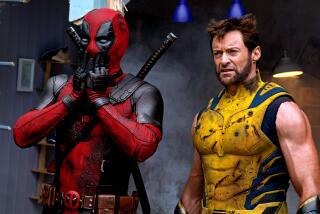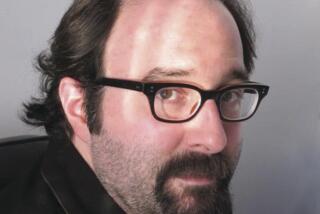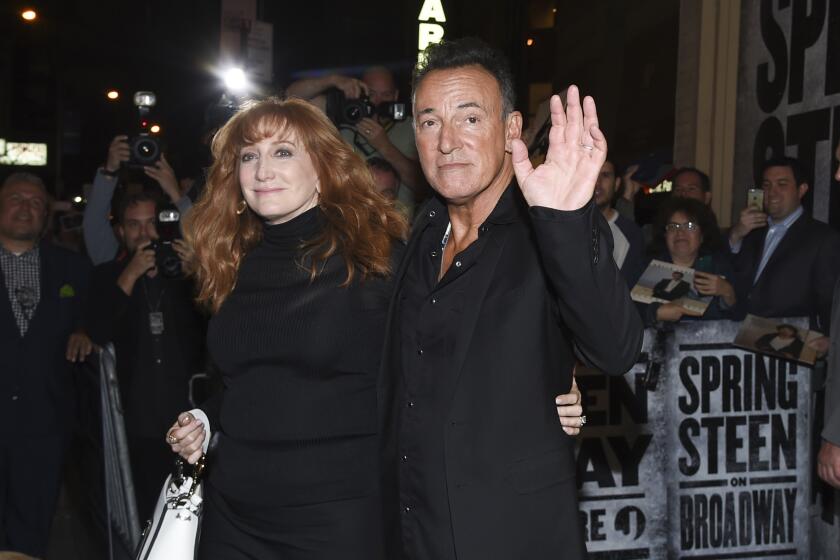From ‘Black Panther’ to ‘Ready Player One’: Hollywood places big bets on spring as the new launching point for blockbuster titles
For more than 40 years, Steven Spielberg’s movies have followed a simple, binary release strategy. Without exception, his films have either opened in the summer — a moviegoing season he all but invented with the 1975 smash “Jaws” — or toward the end of the year as awards buzz is heating up. The formula is so predictable, you can almost set a watch by it.
Yet when executives at Warner Bros. sat down with the director to discuss the release plan for his latest film, the big-budget sci-fi-action epic “Ready Player One,” they had something different in mind. Set in a near-future dystopia in which people live much of their lives in a virtual-reality realm called the OASIS, Spielberg’s adaptation of Ernest Cline’s bestselling novel has all the bells and whistles of a big, fun summer movie.
But the studio wanted to open it in March — a month that has not seen the release of a Spielberg movie since his very first feature, “The Sugarland Express,” hit theaters on March 31, 1974.
Spielberg went for the idea without hesitation. “He was absolutely supportive from day one,” says Jeff Goldstein, president of domestic distribution at Warner Bros. “He totally bought our approach and our passionate feeling that this was where we have to go.”
‘Black Panther,’ ‘Annihilation’ and ‘Isle of Dogs’ highlight films due this Winter and Spring »
Until fairly recently, such a move would have been almost unthinkable. For decades, spring was largely considered a kind of dead zone in Hollywood’s release calendar, an island of cinematic misfit toys lacking a coherent identity or much inherent appeal for film distributors.
“In everyone’s minds, there’s the holiday season, there’s awards season, there’s the summer movie season — and then there’s spring,” says Paul Dergarabedian, senior media analyst for the data firm ComScore. “What the hell is spring?”
But that is changing quickly. Over the last several years, the period running roughly from Valentine’s Day through the end of April has become an increasingly vital window for the studios to release some of their biggest films. The next few months will see a slew of high-profile would-be blockbusters hit the multiplexes, including the climax of the erotic trilogy “Fifty Shades Freed” (Feb. 9), the Marvel film “Black Panther” (Feb. 16), director Ava DuVernay’s fantasy epic “A Wrinkle in Time” (March 9), a reboot of the “Tomb Raider” franchise (March 16), “Ready Player One” (March 30) and the Dwayne Johnson sci-fi-action film “Rampage” (April 20).
“If you’ve got a big tentpole, it can absolutely survive and do extraordinary well in this spring quarter,” says Jim Orr, president of domestic distribution at Universal Pictures, which, along with “Fifty Shades Freed,” will also release the giant robots-versus-giant monsters sequel “Pacific Rim Uprising,” starring John Boyega, on March 23. “People are coming out of the winter doldrums and looking for great escapism.”
2018’s tentpole-packed first quarter follows a 2017 spring season that shattered box office records. Fueled by smashes like “Beauty and the Beast” (the second highest grossing film of 2017 after “Star Wars: The Last Jedi”), “Logan,” and “The Fate of the Furious,” collective domestic grosses in March and April reached nearly $2 billion, a benchmark that seemed inconceivable not so long ago. Meanwhile, February saw three films — “The Lego Batman Movie,” “Get Out” and “Fifty Shades Darker” — clear the $100 million mark domestically, tying the record for the month.
For Hollywood, the growing potency of the spring season over the last decade has essentially been a case of “if you build it, they will come.” As studios started to move larger films like “Fast and Furious,” “Alice in Wonderland” and “The Hunger Games” into time frames once relatively lacking in box office fireworks, audiences followed.
“Suddenly, what was once kind of a slow period became a land of opportunity,” says Dergarabedian. “And now the secret is out.”
For the major studios, expanding the calendar in search of any competitive advantage is ultimately a matter of necessity. “As more studios have invested in these big-bet tentpoles, there’s just so many places to put them,” says Goldstein. “It’s a three-dimensional chessboard: ‘If they go here, you’ll do this.’ We’re all following what we can to learn about other studios’ films, and we’re all pretty quick on our feet.”
For Universal, a February release for “Fifty Shades Freed” — the final installment in the trilogy based on E.L. James’ bestselling novels — was a veritable no-brainer after the first two films found massive success in a similar time frame. “In 2015, when the first ‘Fifty Shades’ was released, Valentine’s Day was a Saturday, so it was just a perfect storm of a property people could not wait to see that had an extraordinarily large fan base and an amazingly good date,” says Orr. “So we’ve kept the next two installments around that time. It’s just been a great combination of release date, topic and filmmaking.”
While Disney found huge success releasing “Captain America: The Winter Soldier” in spring 2014, the decision to release director Ryan Coogler’s “Black Panther” — the first film in the Marvel Cinematic Universe to center on a black superhero, played by Chadwick Boseman — in February seemed surprising to some. But Dave Hollis, Disney’s president of theatrical distribution, points to the massive success of 20th Century Fox’s “Deadpool,” which was released in February 2016 and grossed a record-setting $783 million worldwide, as an indication of how powerful a draw a comic-book title can be in that month.
“I guess you could say that February is a little less quote-unquote ‘conventional,’ ” says Hollis. “But looking back at what ‘Deadpool’ was able to do gives us a lot of confidence. And in a year in which Marvel has three films — ‘Black Panther’ in February, ‘Avengers: Infinity War’ in May and ‘Ant-Man and the Wasp’ in July — we have to look at a little bit of a distinct date just so we create spacing and don’t cannibalize our business.”
For moviegoers, March will feel almost like a summer month, with at least one studio tentpole opening every weekend. On March 2, 20th Century Fox’s spy thriller “Red Sparrow” will hit theaters, reuniting Jennifer Lawrence — who plays a deadly Russian assassin — with director Francis Lawrence, who helmed three of the four “Hunger Games” films.
Later in the month, Alicia Vikander will play a very different fierce female character, archaeologist and adventurer Lara Croft, in Warner Bros. and MGM’s videogame-adaptation reboot “Tomb Raider” — a role that was played twice on the big screen in the early 2000s by Angelina Jolie.
Despite the increased competition in March, Disney expects “A Wrinkle in Time” — with its potent pedigrees of Madeleine L’Engle’s much-loved book and stars Oprah Winfrey, Reese Witherspoon and Mindy Kaling — to perform strongly. “It sits in what for us has been a sweet spot since 2010 [with ‘Alice in Wonderland’],” Hollis says. “We had the 2017 success of ‘Beauty and the Beast.’ In 2016, it was ‘Zootopia.’ In 2015, we had ‘Cinderella,’ and in 2013, we had ‘Oz the Great and Powerful.’ For us, it’s been an if-it-ain’t-broke, don’t-fix-it mentality.”
In April, Warner Bros. will tap the star power of Dwayne Johnson in “Rampage,” loosely based on a popular video game series and featuring a slew of giant beasts not entirely unlike those seen in “Kong: Skull Island,” which proved a hit for the studio last March. “Talk about a real bankable star,” Goldstein says of Johnson, citing the huge success of his latest film, “Jumanji: Welcome to the Jungle,” which has grossed more than $500 million worldwide. “I think in ‘Rampage’ he’s going to really hit his audience again.”
Of course, even as spring has become an increasingly hospitable home for tentpole movies that may feel slightly too risky to place in the heart of the summer, it does have its limitations. Aside from spring break and the occasional holiday, kids are in school and the ability to rack up big grosses in midweek showings is generally reduced. And odds are a movie released early in the year may have a tough time sticking in people’s minds all the way until awards season — though Universal’s “Get Out” is a bona-fide contender nearly a year after its release.
In the end, whatever the time of year, when it comes to releasing movies, the only thing that’s truly certain is that nothing is truly certain. “Every time we think we have a rule that’s made sense in the past, something will come along — either by accident or by design — and will just blow it up, in a very positive way,” Orr says.
Twitter: @joshrottenberg
More to Read
Only good movies
Get the Indie Focus newsletter, Mark Olsen's weekly guide to the world of cinema.
You may occasionally receive promotional content from the Los Angeles Times.











